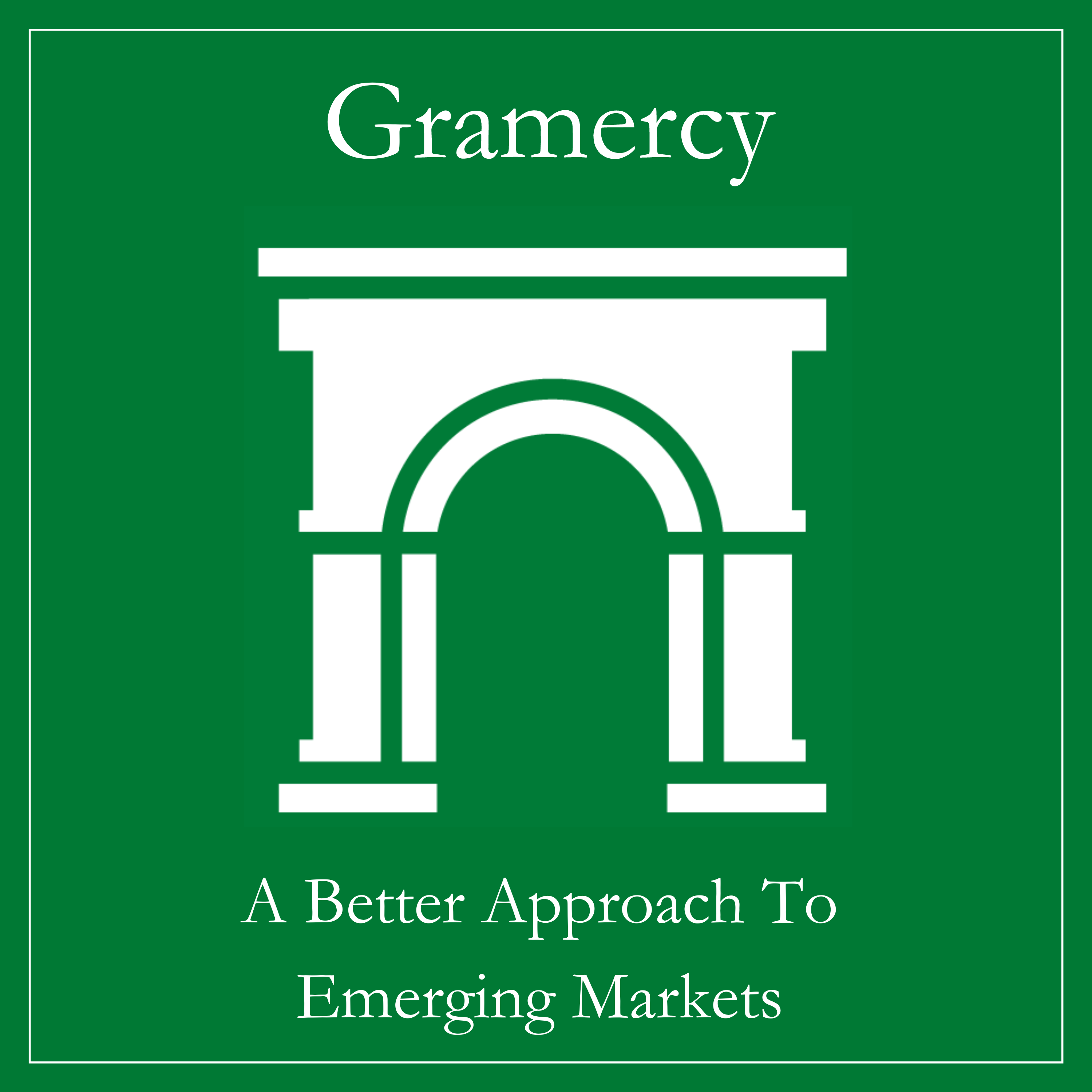Contents
Market Overview
Macro Review
Markets continue to second-guess the Fed’s December 18th policy move, with the overnight index swaps (OIS) now pricing in a 95% probability of a rate cut compared to 65% two weeks earlier. With YoY core CPI hopefully set to move a tick lower in January, focus is now on labor market data following the higher-than-expected November unemployment rate and a relatively lackluster non-farm payrolls release. The picture continues to be blurred by so-called QCEW data, which is released with a few months’ lag and indicates lower actual payrolls data than the NFP releases. That presents a challenge for the Fed in its decision-making process. The ECB, meanwhile, appears comfortable with market perceptions of 125bps rate cuts through October 2025, a sizeable 50-75bps more than the BoE and Fed, assuming the latter cuts its policy rate on December 18th. With the U.S. dollar on a stronger footing and UST yields up again, EM central banks are having to show their teeth. Brazil’s Central Bank hiked rates by a more-than-expected 100bps and Bank Indonesia undertook “a quite bold triple intervention” to stem IDR weakness (according to one official). Looking to China, the jury is still out regarding official stimulus measures aimed at animating private sector consumption, an important second-derivative concern for emerging markets. On the geopolitical front, all eyes remain on the Middle East following last week’s historic developments in Syria and their implications for many countries further afar. Otherwise, the last major election of a bumper global elections year saw Ghana’s opposition win a sizeable mandate to place the country on a solid growth path.
EM Credit Update
EM equities were able to outperform most assets classes this week, with China leading the way. However, judging by the subsequent drop in Chinese equities on Friday the 13th, markets need more official guidance on how the Government plans to jump-start growth. EM corporate and sovereign USD bonds ended the week relatively flat, with CEE slightly outperforming peers.
The Week Ahead
Besides next week’s FOMC meeting and the December 20th U.S. Core PCE print, focus will be on U.S. real economy data releases, including retail sales, PMIs and industrial production. In the Eurozone, Consumer Confidence and Germany’s ZEW expectations survey stand out, while in the UK, the BoE will have the November CPI release before it meets on December 19th, with retail sales only to be released a day later. Japan’s BoJ and Mexico’s Banxico also meet on December 19th, with JPY currently more under pressure than MXN.
Highlights from emerging markets discussed below: Brazil’s Central Bank delivers a 100bps rate hike and hawkish guidance, BRL recovers some ground; Ghana general election delivers solid mandate for opposition NDC; and China signals looser policy conditions.
Fixed Income
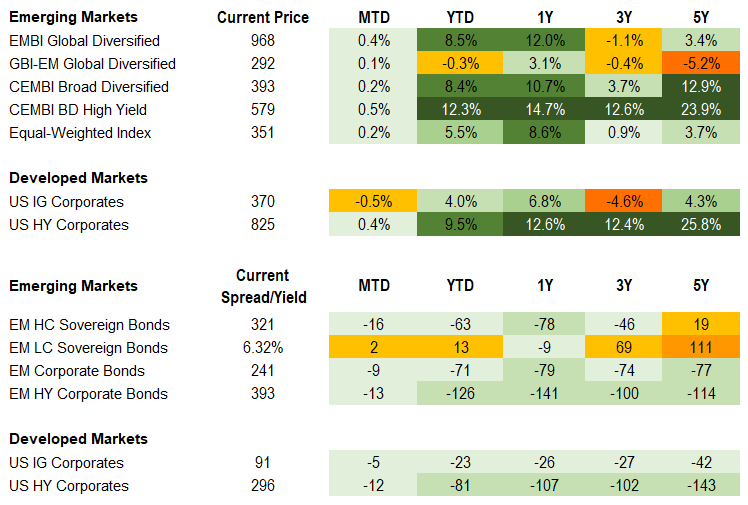
Equities
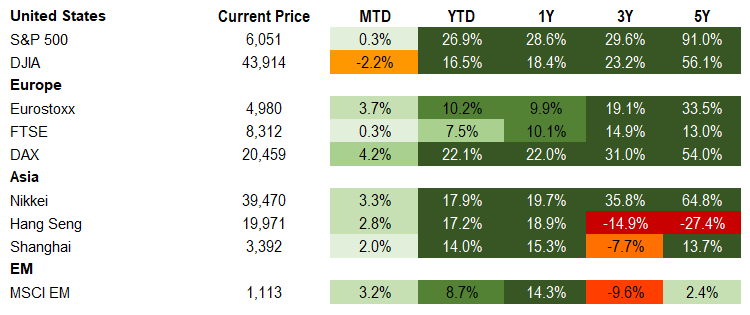
Commodities

Source for data tables: Bloomberg, JPMorgan, Gramercy. EM Fixed Income is represented by the following JPMorgan Indicies: EMBI Global, GBI-EM Global Diversified, CEMBI Broad Diversified and CEMBI Broad High Yield. DM Fixed Income is represented by the JPMorgan JULI Total Return Index and Domestic High Yield Index. Fixed Income, Equity and Commodity data is as of December 13, 2024 (mid-day).
Emerging Markets Weekly Highlights
Brazil’s Central Bank delivers a 100bps rate hike and hawkish guidance, BRL recovers some ground
Event: The Brazilian Central Bank (BCB) raised the Selic benchmark interest rate by 100bps to 12.25%, overdelivering on consensus market expectations of a 75bps hike. The COPOM, BCB’s monetary policy setting committee, also issued hawkish forward guidance, signaling “further adjustments of the same magnitude in the next two meetings, if the scenario evolves as expected”.
Gramercy Commentary: This was the last monetary policy rate decision under outgoing Governor Roberto Campos Neto, a political opponent to President Lula. Mr. Campos Neto will be replaced in January by Lula-appointee Gabriel Galipolo, BCB’s Director of Monetary Policy until now and a sitting COPOM member. BCB’s more aggressive than expected monetary policy tightening and hawkish guidance as the new Lula-appointed leadership team is about to take over sends a constructive message to markets about continuation of independent and credible monetary policy management, a credit-positive. The policymakers highlighted recent further de-anchoring of medium-term inflation expectations, stronger- than-expected domestic economic activity and a likely more adverse external environment as the main factors supporting an even more restrictive monetary policy stance. Brazilian assets gained, led by the BRL that has been under strong downside pressure lately due to mounting concerns from local investors about the Government’s medium-term fiscal trajectory and skepticism about President Lula’s ability/willingness to commit to significant budget cuts next year. Further market gains will be subject to the approval by Congress of credible deficit cutting measures, subject to Lula’s political blessing, which we think is unlikely before year end but possible in 1Q 2025.
Ghana general election delivers solid mandate for opposition NDC
Event: Ghana held presidential and legislative elections on December 7th where the center-left opposition NDC (National Democratic Congress) candidate and former President John Mahama secured a decisive victory with 56% of the vote and the party obtaining a super-majority in Parliament. Mahamudu Bawumia, the candidate from the ruling center-right NPP (National Patriotic Party) and current Vice President, only obtained 41% of the vote and swiftly conceded in the aftermath. Turnout was just shy of 64% and comfortably below the 79% and 69% turnouts in the 2020 and 2016 elections.
Gramercy Commentary: We see the election outcome as broadly neutral for assets as an NDC victory does not come as a surprise to markets and general policy continuity is expected. Investors will focus on upcoming cabinet appointments, particularly within the Ministry of Finance and implications for the current $3bn EFF program with the IMF which runs through 2026. Following the recent successful completion of the Eurobond restructuring, we expect the new Administration to prioritize macroeconomic stability and recovery with a solid ability to execute. As such, we think the Government will stay the course with the Fund with possible amendments to the existing facility and some speculation of extension to 2028.
China signals looser policy conditions
Event: The Politburo Committee and Central Economic Work Conference signaled additional policy support for the economy in 2025 including “moderately loose” monetary policy with lower interest rates, reserve requirement ratio cuts, additional special government bond issuance and a larger budget deficit with domestic demand efforts as a top priority and an aim to “vigorously boost consumption”. Housing policy will continue to limit declines and aim for stability without reference to new policies to tackle elevated inventory.
Gramercy Commentary: The reiteration of additional measures to shore-up growth in 2025 is in line with our expectations for a step-up in stimulus amid still pressured domestic demand and uncertainty with respect to U.S. trade policy. While details remain scant on size and scope, the Central Economic Work Conference does not usually provide such specifics and there will likely continue to be a preference to adjust stimulus needs based on domestic economic outcomes and the nature of U.S. tariff hikes as opposed to announcing a preemptive large scale ‘bazooka’ package at this stage. The market’s focus will next shift to Trump’s first policy actions in 1Q25 as well as the upcoming NPC in March.
Emerging Markets Technicals
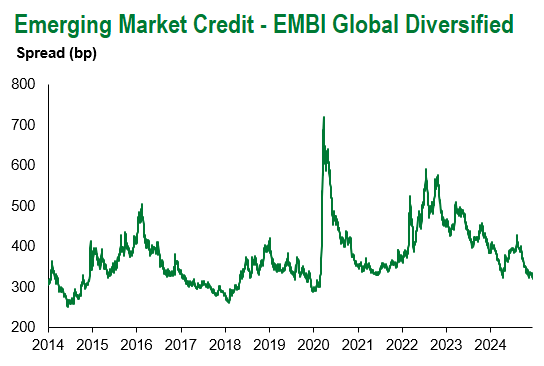
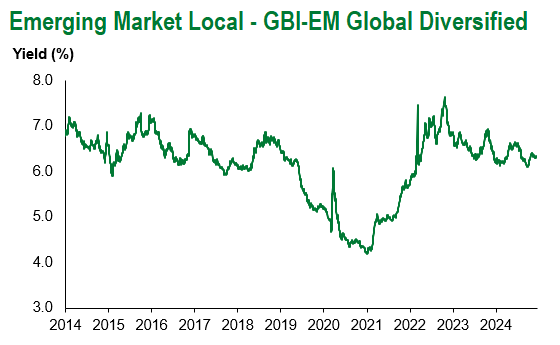
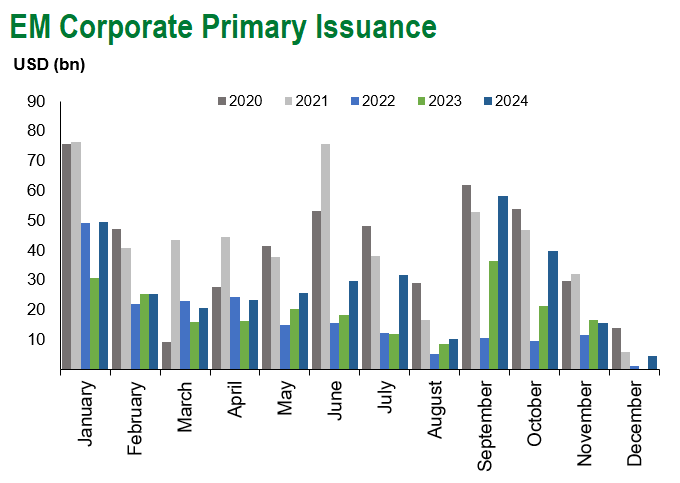
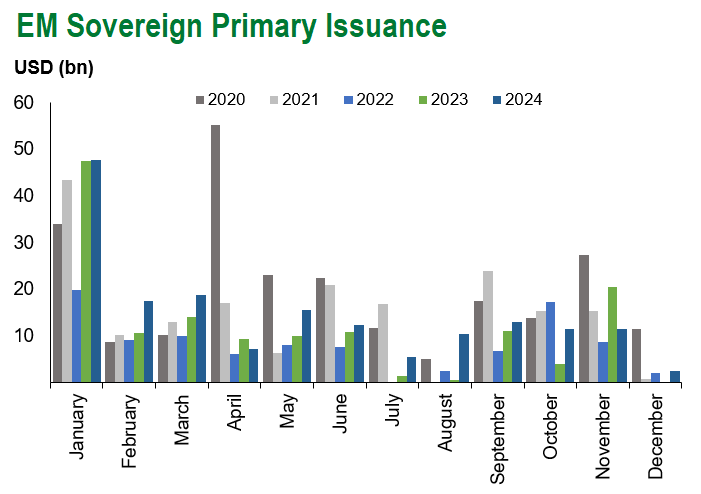
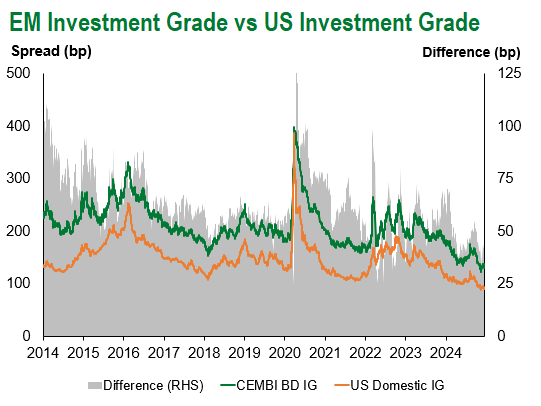
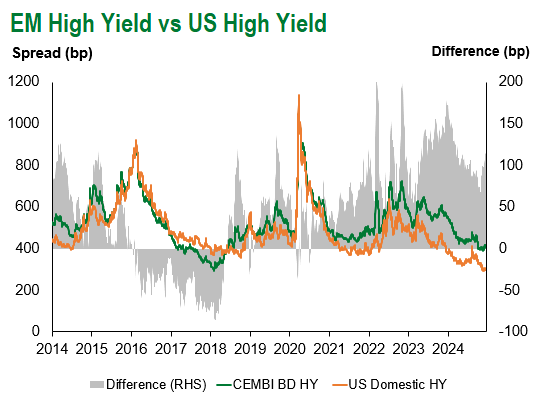
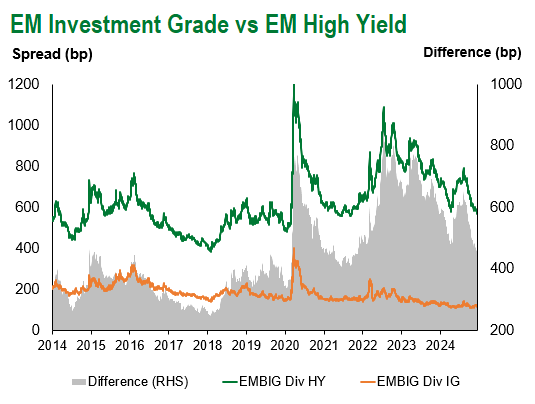
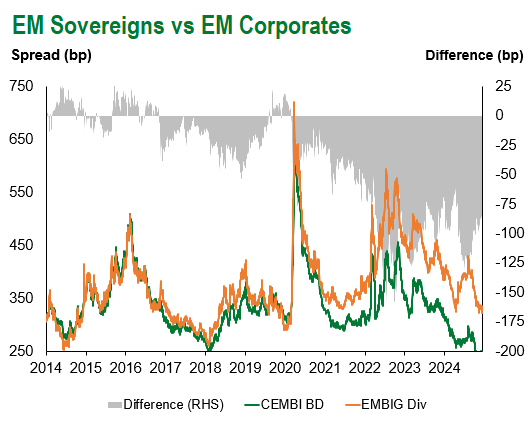
Emerging Markets Flows
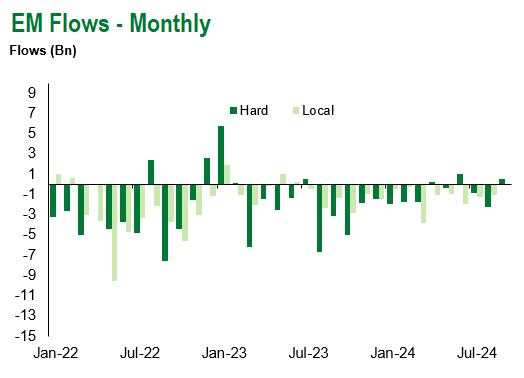
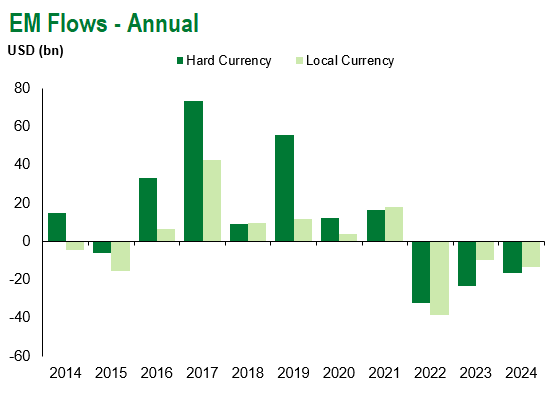
Source for graphs: Bloomberg, JPMorgan, Gramercy. As of December 13, 2024.
For questions, please contact:
Simon Quijano-Evans, Managing Director, Chief Strategist, [email protected]
Kathryn Exum, CFA ESG, Director, Co-Head of Sovereign Research, [email protected]
Petar Atanasov, Director, Co-Head of Sovereign Research, [email protected]
James Barry, Director, Deputy Portfolio Manager, [email protected]
This document is for informational purposes only. The information presented is not intended to be relied upon as a forecast, research or investment advice, and is not a recommendation, offer or solicitation to buy or sell any securities or to adopt any investment strategy. Gramercy may have current investment positions in the securities or sovereigns mentioned above. The information and opinions contained in this paper are as of the date of initial publication, derived from proprietary and nonproprietary sources deemed by Gramercy to be reliable, are not necessarily all-inclusive and are not guaranteed as to accuracy. This paper may contain “forward-looking” information that is not purely historical in nature. Such information may include, among other things, projections and forecasts. There is no guarantee that any forecasts made will come to pass. Reliance upon information in this paper is at the sole discretion of the reader. You should not rely on this presentation as the basis upon which to make an investment decision. Investment involves risk. There can be no assurance that investment objectives will be achieved. Investors must be prepared to bear the risk of a total loss of their investment. These risks are often heightened for investments in emerging/developing markets or smaller capital markets. International investing involves risks, including risks related to foreign currency, limited liquidity, less government regulation, and the possibility of substantial volatility due to adverse political, economic or other developments. References to any indices are for informational and general comparative purposes only. The performance data of various indices mentioned in this update are updated and released on a periodic basis before finalization. The performance data of various indices presented herein was current as of the date of the presentation. Please refer to data returns of the separate indices if you desire additional or updated information. Indices are unmanaged, and their performance results do not reflect the impact of fees, expenses, or taxes that may be incurred through an investment with Gramercy. Returns for indices assume dividend reinvestment. An investment cannot be made directly in an index. Accordingly, comparing results shown to those of such indices may be of limited use. The information provided herein is neither tax nor legal advice. Investors should speak to their tax professional for specific information regarding their tax situation.
